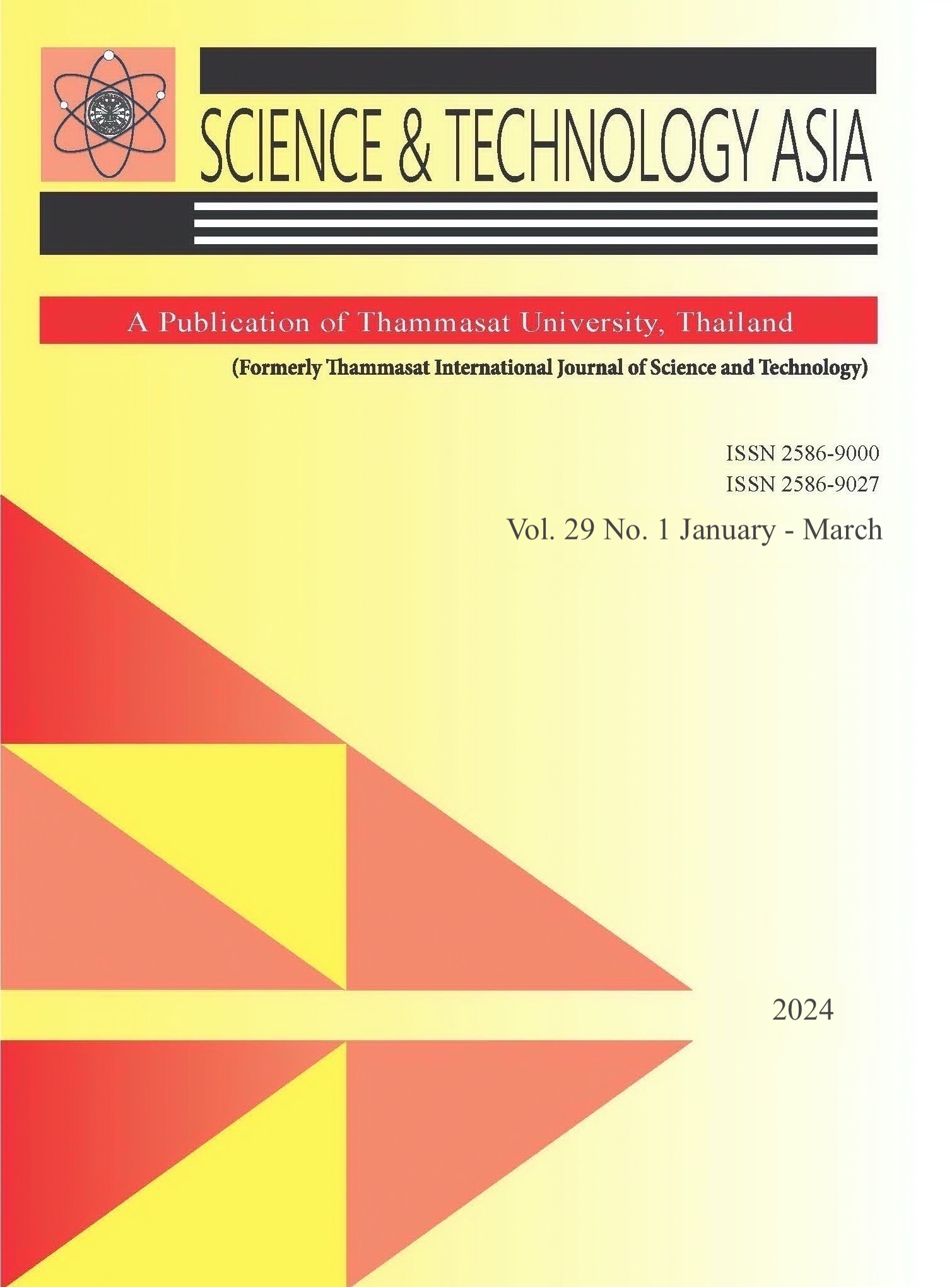Biochemical Properties of Myofibrillar Protein and Gel Characteristics of Surimi from Rohu (Labeo rohita) as Affected by Frozen Storage
Main Article Content
Abstract
The effects of frozen storage at -18ºC on the biochemical properties of myofibrillar protein (MF) extracted from rohu (Labeo rohita) surimi, and the gel characteristics of surimi were investigated. Biochemical changes were determined by the Ca2+-ATPase activity, total and reactive sulfhydryl (SH) content, and SDS-PAGE patterns. The gel properties were determined by gel strength, water holding capacity (WHC), whiteness, and from observations of the SDS-PAGE patterns and microstructure. Extended frozen storage was found to affect myosin. This was reflected in Ca2+-ATPase activity, reactive SH content, and myosin heavy chain intensity, which also decreased as the storage period was extended. This was confirmed by the decreasing of gel strength and WHC, the degradation of myosin heavy chain, and the formation of large protein clusters. The whiteness increased as the frozen storage time increased. This suggested that extended storage at -18ºC caused myosin denaturation, which in turn lead to a change of gel properties.
Article Details

This work is licensed under a Creative Commons Attribution-NonCommercial-NoDerivatives 4.0 International License.
References
National Statistical Office of Thailand. Statistical data of freshwater fish in Thailand [Internet]. (cited 2014 July 15). Available from http://service.nso.go.th/nso/nso_center/project/search_ center/23project-th.html/
Rawdkaen S. Sai-Ut S. Khamsorn S. Chaijan M. Benjakul S. Biochemical and gelling properties of tilapia surimi and protein recovered using an acid-alkaline process. Food Chem 2009; 112: 112-119.
Mahawanich T. Lekhavichitr J. Duangmal K. Gel-properties of red tilapia surimi: effects of setting condition, fish freshness and frozen storage. Int J Food Sci Technol 2010; 45: 1777-1786.
Yongsawatdigul J. Pivisan S. Wongngam W. Benjakul S. Gelation characteristics of minced and washed mince from Small-scale mud carp and common carp. J Aquat Food Prod Technol 2013; 22: 460-473.
Park JW. Lin TMJ. Surimi: Manufacturing and Evaluation: Surimi and surimi seafood (2nd ed.) New York: CRC Press. 2005.
Lanier TC. Carvajal P. Yongsawatdikul J. Surimi gelation chemistry: Surimi and surimi seafood (2nd ed.) New York: CRC Press. 2005.
Yongsawatdigul J. Piyadhammaviboon P. Inhibition of autolytic activity of lizardfish surimi by proteinase inhibitors. Food Chem 2004; 87: 447-455.
Li YQ. Kong BH. Xia XF. Liu PJ. Inhibition of frozen storage-induced oxidation and structural changes in myofibril of common carp (Cyprinus carpio) surimi by cryoprotectant and hydrolysed whey protein addition. Int J Food Sci Technol 2013; 48: 1916-1923.
Cao L. An Y. Xiong S. Li S. Liu R. Conformational changes and kinetic study of actomyosin from silver carp surimi with modified starch-sucrose mixtures during frozen storage. J Food Qual 2016; 39: 54-63.
Benjakul S. Visessanguan W. Thongkeaw C. Tanaka M. Effect of frozen storage on chemical and gel-forming properties of fish commonly used for surimi production in Thailand. Food Hydrocoll 2005; 19: 197-207.
Pan J. Shen H. Luo Y. Cryoprotective effect of trehalose on grass carp (Ctenopharyngodon idellus) surimi during frozen storage. J Food Process Preserv 2010; 34: 715-727.
Lu H. Zhang L. Li Q. Luo Y. Comparison of gel properties and biochemical characteristics of myofibrillar protein from bighead carp (Aristichthys nobilis) affected by frozen storage and a hydroxyl radical-generation oxidizing system. Food Chem 2017; 223: 96-103.
Sutloet P. Sompongse W. Morioka K. Effect of setting condition on gel-forming ability of rohu. J Aquat Food Prod Technol 2018; 27: 247-257.
Sompongse W. Itoh Y. Obatake A. Role of SHa in the polymerization of myosin heavy chain during ice storage of carp actomyosin. Fish Sci 1996b; 62: 110-113.
Lowry OH. Rosebrough NJ. Farr AL. Randall RJ. Protein measurement with the folin phenol reagent. J Biol Chem 1951; 193: 265-275.
Sompongse W. Itoh Y. Obatake A. Effect of cryoprotectants and a reducing reagent on the stability of actomyosin during ice storage. Fish Sci 1996a; 62; 73-79.
Takashi R. Arai K. Saito T. Studies on Muscular Proteins of Fish-II. Preparation of Actomyosin from Carp Muscle. Nippon Suisan Gakk 1970; 36: 169-172.
Ellman GL. Tissue sulfhydryl group. Arch Biochem Biophys 1959; 82: 70-77.
Laemmli UK. Cleavage of structural proteins during the assembly of the head of bacteriophage T4. Nature 1970; 227: 680-685.
Sutloet P. Sompongse W. Morioka K. Effect of whey protein concentrate on gel-forming ability of rohu (Labeo rohita). J Adv Agri Technol 2017; 4: 222-228.
Benjakul S. Visessanguan W. Thongkeaw C. Tanaka M. Comparative study on physicochemical changes of muscle proteins from some tropical fish during frozen storage. Food Res Int 2003; 36: 787-795.
Okada T. Inoue N. Akiba M. Electron microscopic observation and biochemical properties of carp myosin B during frozen storage. Nippon Suisan Gakk 1986; 52: 345-353.
Benjakul S. Bauer F. Physicochemical and enzymatic changes of cod muscle proteins subjected to different freeze-thaw cycles. J Sci Food Agri 2000; 80: 1143-1150.
Riebroy S. Benjakul S. Visessanguan W. Erikson U. Rustad T. Acid-induced gelation of natural actomyosin from Atlantic cod (Gadus morhua) and burbot (Lota lota). Food Hydrocoll 2009; 23: 26-39.
Liu R. Zhao SM. Yang H. Li DD. Xiong SB. Xie BJ. Comparative study on the stability of fish actomyosin and pork actomyosin. Meat Sci 2011; 88: 234-240.
Kittiphattanabawon P. Benjakul S. Visessanguan W. Shahidi F. Cryoprotective effect of gelatin hydrolysate from blacktip shark skin on surimi subjected to different freeze-thaw cycles. LWT-Food Sci Technol 2012; 47: 437-442.
Buttkus H. Accelerated denaturation of myosin in frozen solution. J Food Sci 1970; 35: 558-562.
Kielley WW. Bradley LB. The relationship between sulfhydryl groups and the activation of myosin adenosine triphosphatase. J Biol Chem 1956; 218: 653-659.
Benjakul S. Sutthipan N. Muscle changes in hard and soft shell crabs during frozen storage. LWT-Food Sci Technol 2009; 42: 723-729.
Shenouda SYK. Theories of protein denaturation during frozen storage of fish fresh. Adv Food Res 1980; 26: 275-311.
Park JW. Cryoprotection of muscle proteins by carbohydrates and polyalcohols-A review. J Aquat Food Prod Technol 1994; 3: 23-41.
Sikorski ZE. Pan BS. Preservation of seafood quality: Seafood chemistry, processing technology and quality (1st ed.). USA: Springer. 1994.


